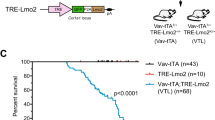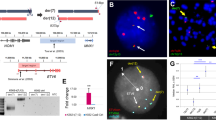Abstract
Chromosomal translocations involving the Mixed-Lineage Leukaemia (MLL) gene underlie many human leukaemias and MLL rearrangements are found in both acute myelogenous and acute lymphoblastic leukaemias. To assess the functionally relevant haematopoietic cell contexts for MLL fusions to be tumorigenic, we have generated different lines of mice in which de novo Mll-associated translocations occur. In these models, reciprocal chromosomal translocations occur by means of Cre-loxP-mediated recombination (translocator mice) in different cells of the haematopoietic system (namely haematopoietic stem cells, semi-committed progenitors or committed T or B cells). Translocations between Mll and Enl cause myeloid neoplasias, initiating in stem cells or progenitors while no tumours arose when the translocation was restricted to the B-cell compartment. Despite the absence of tumorigenesis, Mll-Enl translocations did occur and Mll-Enl fusion mRNA was expressed in B-cell-restricted translocators. A permissive cellular environment is therefore required for oncogenicity of Mll-associated translocations since the occurrence of Mll-Enl does not promote unrestricted proliferation in all haematopoietic cellular contexts, consistent with a specific instructive role of the MLL-fusion proteins in leukaemogenesis.
This is a preview of subscription content, access via your institution
Access options
Subscribe to this journal
Receive 50 print issues and online access
$259.00 per year
only $5.18 per issue
Buy this article
- Purchase on Springer Link
- Instant access to full article PDF
Prices may be subject to local taxes which are calculated during checkout




Similar content being viewed by others
References
Ayton PM, Cleary ML . (2003). Transformation of myeloid progenitors by MLL oncoproteins is dependent on Hoxa7 and Hoxa9. Genes Dev 17: 2298–2307.
Bloomfield CD, Archer KJ, Mrozek K, Lillington DM, Kaneko Y, Head DR et al. (2002). 11q23 balanced chromosome aberrations in treatment-related myelodysplastic syndromes and acute leukemia: report from an international workshop. Genes Chromosomes Cancer 33: 362–378.
Collins EC, Pannell R, Simpson EM, Forster A, Rabbitts TH . (2000). Inter-chromosomal recombination of Mll and Af9 genes mediated by cre-loxP in mouse development. EMBO Rep 1: 127–132.
Corral J, Lavenir I, Impey H, Warren AJ, Forster A, Larson TA et al. (1996). An Mll-Af9 fusion gene made by homologous recombination causes acute leukemia in chimeric mice: a method to create fusion oncogenes. Cell 85: 853–861.
Cozzio A, Passegue E, Ayton PM, Karsunky H, Cleary ML, Weissman IL . (2003). Similar MLL-associated leukemias arising from self-renewing stem cells and short-lived myeloid progenitors. Genes Dev 17: 3029–3035.
Daser A, Rabbitts TH . (2004). Extending the repertoire of the mixed lineage leukemia gene MLL in leukemogenesis. Genes Dev 18: 965–974.
Drynan LF, Pannell R, Forster A, Chan NMM, Cano F, Daser A et al. (2005). Mll fusions generated by Cre-lox P-mediated de novo translocations can induce lineage reassignment in tumorigenesis. EMBO J 24: 3136–3146.
Felix CA . (2001). Leukemias related to treatment with DNA topoisomerase II inhibitors. Med Pediatr Oncol 36: 525–535.
Forster A, Pannell R, Drynan LF, McCormack M, Collins EC, Daser A et al. (2003). Engineering de novo reciprocal chromosomal translocations associated with Mll to replicate primary events of human cancer. Cancer Cell 3: 449–458.
Huret JL, Dessen P, Bernheim A . (2001). An atlas of chromosomes in hematological malignancies. Example: 11q23 and MLL. Leukaemia 15: 987–999.
Kogan SC, Ward JM, Anver MR, Berman JJ, Brayton C, Cardiff RD et al. (2002). Bethesda proposals for classification of nonlymphoid hematopoietic neoplasms in mice. Blood 100: 238–245.
McCormack MP, Forster A, Drynan LF, Pannell R, Rabbitts TH . (2003). The LMO2 T-cell oncogene is activated via chromosomal translocations or retroviral insertion during gene therapy but has no mandatory role in normal T-cell development. Mol Cell Biol 23: 9003–9013.
Metzler M, Forster A, Pannell R, Arends MJ, Daser A, Lobato MN et al. (2006). A conditional model of MLL-AF4 B-cell tumourigenesis using invertor technology. Oncogene 25: 3093–3103.
Milne TA, Briggs SD, Brock HW, Martin ME, Gibbs D, Allis CD et al. (2002). MLL targets SET domain methyltransferase activity to Hox gene promoters. Mol Cell 10: 1107–1117.
Milne TA, Martin ME, Brock HW, Slany RK, Hess JL . (2005). Leukemogenic MLL fusion proteins bind across a broad region of the Hox a9 locus, promoting transcription and multiple histone modifications. Cancer Res 65: 11367–11374.
Pui CH, Campana D . (2007). Age-related differences in leukemia biology and prognosis: the paradigm of MLL-AF4-positive acute lymphoblastic leukemia. Leukemia 21: 593–594.
Pui CH, Gaynon PS, Boyett JM, Chessells JM, Baruchel A, Kamps W et al. (2002a). Outcome of treatment in childhood acute lymphoblastic leukaemia with rearrangements of the 11q23 chromosomal region. Lancet 359: 1909–1915.
Pui CH, Relling MV, Campana D, Evans WE . (2002b). Childhood acute lymphoblastic leukemia. Rev Clin Exp Hematol 6: 161–180; discussion 200–202.
Rabbitts TH . (1991). Translocations, master genes, and differences between the origins of acute and chronic leukemias. Cell 67: 641–644.
Rickert RC, Roes J, Rajewsky K . (1997). B lymphocyte-specific, Cre-mediated mutagenesis in mice. Nucleic Acids Res 25: 1317–1318.
Srinivas S, Watanabe T, Lin CS, William CM, Tanabe Y, Jessell TM et al. (2001). Cre reporter strains produced by targeted insertion of EYFP and ECFP into the ROSA26 locus. BMC Dev Biol 1: 4.
Acknowledgements
This work was funded by the Medical Research Council. FC was supported by the César Milstein Memorial studentship of the Darwin Trust, Edinburgh. We thank Mark Bowen for his help with the histology sample preparations and Angela Middleton and Gareth King for assistance with the animal welfare.
Author information
Authors and Affiliations
Corresponding author
Additional information
Supplementary Information accompanies the paper on the Oncogene website (http://www.nature.com/onc).
Supplementary information
Rights and permissions
About this article
Cite this article
Cano, F., Drynan, L., Pannell, R. et al. Leukaemia lineage specification caused by cell-specific Mll-Enl translocations. Oncogene 27, 1945–1950 (2008). https://doi.org/10.1038/sj.onc.1210818
Received:
Revised:
Accepted:
Published:
Issue Date:
DOI: https://doi.org/10.1038/sj.onc.1210818
Keywords
This article is cited by
-
ENL: structure, function, and roles in hematopoiesis and acute myeloid leukemia
Cellular and Molecular Life Sciences (2018)
-
MLL-ENL-mediated leukemia initiation at the interface of lymphoid commitment
Oncogene (2017)
-
Dysregulation of haematopoietic stem cell regulatory programs in acute myeloid leukaemia
Journal of Molecular Medicine (2017)
-
Haploinsufficiency of the MLL and TOB2 genes in lymphoid malignancy
Leukemia (2010)
-
MLL gene fusions in human leukaemias: in vivo modelling to recapitulate these primary tumourigenic events
International Journal of Hematology (2008)



